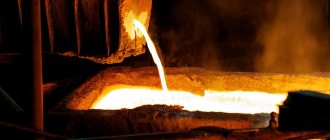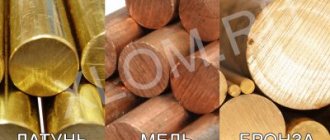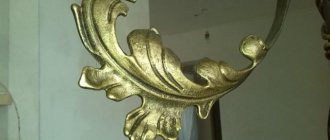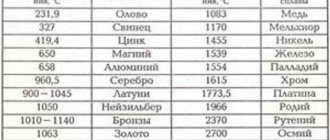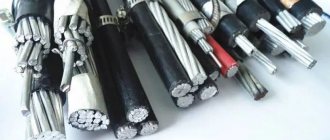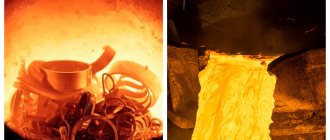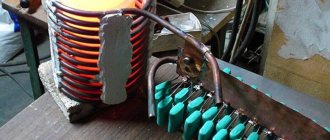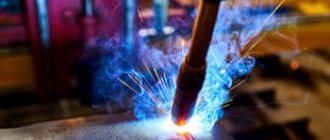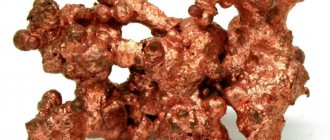Thermal conductivity of brass and bronze
The table shows the thermal conductivity values of brass, bronze, as well as copper-nickel alloys (constantan, copel, manganin, etc.) depending on temperature - in the range from 4 to 1273 K.
Thermal conductivity of brass, bronze and other copper-based alloys when heated increases. According to the table, L96 brass has the highest thermal conductivity of the alloys considered at room temperature. Its thermal conductivity at a temperature of 300 K (27°C) is 244 W/(m deg).
Also copper alloys with high thermal conductivity include: brass LS59-1, tombac L96 and L90, tin tombac LTO90-1, rolled tombac RT-90. In addition, the thermal conductivity of brass is generally higher than that of bronze. It should be noted that bronzes with high thermal conductivity include: phosphorus, chromium and beryllium bronzes, as well as BrA5 bronze.
The copper alloy with the lowest thermal conductivity is manganese bronze - its thermal conductivity coefficient at a temperature of 27°C is 9.6 W/(m deg).
The thermal conductivity of copper alloys is always lower than the thermal conductivity of pure copper, all other things being equal.
In addition, the thermal conductivity of copper-nickel alloys is particularly low. The most thermally conductive of them at room temperature is cupronickel MNZhMts 30-0.8-1 with a thermal conductivity of 30 W/(m deg). Thermal conductivity table for brass, bronze and copper-nickel alloys
| Alloy | Temperature, K | Thermal conductivity, W/(m deg) |
| Copper-nickel alloys | ||
| Beryllium copper | 300 | 111 |
| Constantan of foreign production | 4…10…20…40…80…300 | 0,8…3,5…8,8…13…18…23 |
| Constantan MNMts40-1.5 | 273…473…573…673 | 21…26…31…37 |
| Kopel MNMts43-0.5 | 473…1273 | 25…58 |
| Manganin of foreign production | 4…10…40…80…150…300 | 0,5…2…7…13…16…22 |
| Manganin MNMts 3-12 | 273…573 | 22…36 |
| Cupronickel MNZHMts 30-0.8-1 | 300 | 30 |
| Nickel silver | 300…400…500…600…700 | 23…31…39…45…49 |
| Brass | ||
| Automatic brass UNS C36000 | 300 | 115 |
| L62 | 300…600…900 | 110…160…200 |
| L68 deformed brass | 80…150…300…900 | 71…84…110…120 |
| L80 semi-tompak | 300…600…900 | 110…120…140 |
| L90 | 273…373…473…573…673…773…873 | 114…126…142…157…175…188…203 |
| L96 tombak drawn | 300…400…500…600…700…800 | 244…245…246…250…255…260 |
| LAN59-3-2 aluminum-nickel brass | 300…600…900 | 84…120…150 |
| LMC58-2 manganese brass | 300…600…900 | 70…100…120 |
| LO62-1 tin | 300 | 99 |
| LO70-1 tin | 300…600 | 92…140 |
| LS59-1 annealed brass | 4…10…20…40…80…300 | 3,4…10…19…34…54…120 |
| LS59-1V leaded brass | 300…600…900 | 110…140…180 |
| LTO90-1 tombak tin | 300…400…500…600…700…800…900 | 124…141…157…174…194…209…222 |
| Bronze | ||
| BrA5 | 300…400…500…600…700…800…900 | 105…114…124…133…141…148…153 |
| BrA7 | 300…400…500…600…700…800…900 | 97…105…114…122…129…135…141 |
| BrAZhMC10-3-1.5 | 300…600…800 | 59…77…84 |
| BrAZHN10-4-4 | 300…400…500 | 75…87…97 |
| BrAZHN11-6-6 | 300…400…500…600…700…800 | 64…71…77…82…87…94 |
| BrB2, annealed at 573K | 4…10…20…40…80 | 2,3…5…11…21…37 |
| BrKd | 293 | 340 |
| BrKMTs3-1 | 300…400…500…600…700 | 42…50…55…54…54 |
| BrMC-5 | 300…400…500…600…700 | 94…103…112…122…127 |
| BrMTsS8-20 | 300…400…500…600…700…800…900 | 32…37…43…46…49…51…53 |
| BrO10 | 300…400…500 | 48…52…56 |
| BrOS10-10 | 300…400…600…800 | 45…51…61…67 |
| BrOS5-25 | 300…400…500…600…700…800…900 | 58…64…71…77…80…83…85 |
| BrOF10-1 | 300…400…500…600…700…800…900 | 34…38…43…46…49…51…52 |
| BrOTs10-2 | 300…400…500…600…700…800…900 | 55…56…63…68…72…75…77 |
| BrOTs4-3 | 300…400…500…600…700…800…900 | 84…93…101…108…114…120…124 |
| BrOTs6-6-3 | 300…400…500…600…700…800…900 | 64…71…77…82…87…91…93 |
| BrOTs8-4 | 300…400…500…600…700…800…900 | 68…77…83…88…93…96…100 |
| Aluminum bronze | 300 | 56 |
| Aged beryllium bronze | 20…80…150…300 | 18…65…110…170 |
| Manganese bronze | 300 | 9,6 |
| Production leaded bronze | 300 | 26 |
| Phosphor bronze 10% | 300 | 50 |
| Phosphor bronze annealed | 20…80…150…300 | 6…20…77…190 |
| Chromium bronze UNS C18200 | 300 | 171 |
Note: Temperatures in the table are given in degrees Kelvin!
Effect of carbon concentration
The carbon concentration in steel affects the amount of heat transfer:
- Low carbon steels have a high conductivity index. That is why they are used in the manufacture of pipes, which are then used to create the heating system pipeline. The coefficient value varies from 54 to 47 W/(m* K).
- The average coefficient for common carbon steels is a value from 50 to 90 W/(m* K). That is why such material is used in the manufacture of parts for various mechanisms.
- For metals that do not contain various impurities, the coefficient is 64 W/(m* K). This value does not change significantly under thermal influence.
How to melt at home?
How to distinguish between brass and bronze
The answer to this question lies in the equipment used. It’s easy to work with a professional furnace – you just need to set the required temperature with the thermostat and place the crucible inside. The advantage of such equipment is the high temperature, which will allow the home craftsman to work with other alloys, bronze, and non-ferrous metals. A home oven, made accordingly, is also a good way out.
Preparation
The furnace for melting is laid out of refractory bricks (it is better to use grades with increased capacity). It must be securely fixed with a heat-resistant solution, and some craftsmen take measures to protect it from heat exposure - they coat the outside with special compounds. The recommended construction site should be well ventilated, but at the same time reliably sheltered from natural influences. Therefore, sufficiently powerful ventilation is installed in the workshop, or it is placed in the yard under a canopy.
The heating element is ceramic induction tubes. The power of the energy source is at least 30 kW, with the highest possible efficiency, manufactured only from high-quality parts. Additional accessories - a crucible, tongs with rounded edges and a long handle, a spoon for pouring molten metal, it is better to buy factory ones. However, some craftsmen prefer, instead of a graphite container, to make their own crucible from fireclay with an additional protective layer - this can be liquid glass with the addition of talc or a solution of potassium silicate.
When working intensively with metal, the duration of any such device will be short.
Which thermal conductivity measurement method is best for your material?
There are methods for measuring thermal conductivity such as LFA, GHP, HFM and TCT. They differ from each other in the sizes and geometric parameters of the samples used to test the thermal conductivity of metals.
These abbreviations can be deciphered as:
- GHP (hot guard zone method);
- HFM (heat flow method);
- TCT (hot wire method).
The above methods are used to determine the coefficients of various metals and their alloys. At the same time, using these methods, they study other materials, for example, mineral ceramics or refractory materials.
The metal samples on which the research is carried out have overall dimensions of 12.7 × 12.7 × 2.
If you find an error, please select a piece of text and press Ctrl+Enter.
The main differences between the alloys
Brass LS59-1: characteristics and alloy composition, GOST
Despite their similar appearance due to the use of copper as a base, bronze and brass have certain differences due to the addition of tin and zinc. Thanks to this, the scope of application of both materials is quite wide and varied.
Bronze is used quite often by sculptors. It is excellent for the production of monuments, sculptures, busts, fences and other artistic products. It can stand for hundreds of years without changing its shape or structure. Brass is used quite rarely for such purposes, which is due to the high ductility of this alloy, which negatively affects the durability and wear resistance of sculptures.
Brass and bronze
Due to its properties, one of which is resistance to salty sea water, bronze was previously widely used in maritime affairs. In order for brass to achieve the same properties, it is necessary to add alloying components such as aluminum, tin or lead.
Despite the external similarity, there are small differences between bronze and brass that can be seen with the naked eye. The main thing that should be highlighted is the difference between bronze and brass in color. Bronze has a dark brown tint, while brass is lighter, reminiscent of gold due to its yellowish tint.
The main differences between these two alloys should be highlighted:
- Bronze is produced by fusing copper and tin, with the possible addition of various impurities. Brass is obtained by producing an alloy of copper and zinc, but just like bronze, it can contain additional components.
- Bronze has a coarse-grained structure, brass, in turn, is fine-grained and quite smooth. You can see the structure by examining metal products at a fracture.
- Bronze has a dark brown tint, brass has a yellowish tint.
- Bronze is resistant to aggressive external environments, while brass can be destroyed even when exposed to sea water. This is the diversity of applications of alloys.
- Products made from bronze are much stronger and heavier than brass, and are also characterized by increased wear resistance.
- Due to its properties, bronze is used much more often in industry, but brass is used as part of the steel-brass bimetal, the properties of which exceed those of bronze.
Despite many differences, it is quite difficult to determine in everyday life what alloy a product is made of, but using several methods you can cope with this task.
Characteristics of aluminum batteries
Aluminum radiators are characterized by the fact that their outer side is covered with a powder layer, which is resistant to external corrosion, and the inner side is coated with a polymer protective coating.
They have a neat appearance, are light in weight, and belong to the middle price category.
The heating method for aluminum radiators is convection; they can withstand pressures of up to sixteen atmospheres.
Structurally, this type of device is divided into extruded and cast. In the first case, the production process consists of two stages: first, ductile aluminum is extruded into sections, and the top and bottom are injection molded, and then the component parts are glued together with a special compound. In the second case, the entire section is molded under pressure at once. This method makes the structure more durable, allowing it to more stably withstand water hammer that occurs when heating systems are pressure tested before the onset of winter.
The following table shows the heat transfer characteristics of aluminum radiators.
How to care?
How and with what to clean brass at home: the most effective methods
Products made from a bronze alloy require proper periodic maintenance. They should not be neglected. Let’s take a closer look at how to properly care for such items.
- Products made from noble bronze look impressive and attractive only if they are well cleaned and well maintained. All dust accumulations and contaminants that appear on the surface of objects should be regularly removed. To do this, it is best to use a slightly damp cloth. There is no need to rub the products with all your might - be careful.
- To ensure that the original varnish coating lasts on bronze items for as long as possible, you can periodically wash them with a mild soap solution. These actions will be necessary to ensure that cracks or destruction of the varnish layer do not appear on objects.
- If you are a big fan of things polished to a literally flawless shine, it is recommended to clean bronze using specialized powders and reagents. For example, the special cleaner for bronze “Trilon” boasts a good reputation.
- Having completed the deep cleaning of bronze alloy products, it is advisable to thoroughly polish the metal surface. Dry woolen fabric will do the best job for this task.
- Sometimes dry tooth powder, previously diluted in water with the addition of ammonia, is used to clean bronze. You need 1 glass of powder, 1 teaspoon of alcohol. It is advisable to use a stiff brush for cleaning.
- An ancient and traditional way of cleaning bronze is this option: using water in which legumes were previously boiled. Further cleaning is also carried out using a stiff brush. After this, the clean metal product must be rinsed again and wiped clean with a dry cloth.
If you plan to use a rag to clean bronze, it is better to use a flannel option. Particularly carefully and scrupulously it is necessary to clean areas with folds and depressions, since this is where dust and dirt accumulate most actively.
To learn what bronze is and where it is used, see the following video.
Appendix A (mandatory)
Table A.1
| Materials (structures) | Operating humidity of materials w, % by weight, under operating conditions | |
| A | B | |
| 1 Expanded polystyrene | 2 | 10 |
| 2 Expanded polystyrene extrusion | 2 | 3 |
| 3 Polyurethane foam | 2 | 5 |
| 4 Plates made of resol-phenol-formaldehyde foam | 5 | 20 |
| 5 Perlite plastic concrete | 2 | 3 |
| 6 Thermal insulation products made from foamed synthetic rubber “Aeroflex” | 5 | 15 |
| 7 Thermal insulation products made from foamed synthetic rubber “Kflex” | ||
| 8 Mineral wool mats and slabs (based on stone fiber and staple fiberglass) | 2 | 5 |
| 9 Foam glass or gas glass | 1 | 2 |
| 10 Wood-fiber and particle boards | 10 | 12 |
| 11 Fiberboard and wood concrete slabs based on Portland cement | 10 | 15 |
| 12 Reed slabs | 10 | 15 |
| 13 Peat thermal insulation slabs | 15 | 20 |
| 14 Tow | 7 | 12 |
| 15 Gypsum-based boards | 4 | 6 |
| 16 Gypsum cladding sheets (dry plaster) | 4 | 6 |
| 17 Products made of expanded perlite with a bitumen binder | 1 | 2 |
| 18 Expanded clay gravel | 2 | 3 |
| 19 Shungizite gravel | 2 | 4 |
| 20 Crushed stone from blast furnace slag | 2 | 3 |
| 21 Crushed slag pumice and agloporite stone | 2 | 3 |
| 22 Crushed stone and sand from expanded perlite | 5 | 10 |
| 23 Vermiculite expanded | 1 | 3 |
| 24 Sand for construction work | 1 | 2 |
| 25 Cement-slag mortar | 2 | 4 |
| 26 Cement-perlite mortar | 7 | 12 |
| 27 Gypsum perlite solution | 10 | 15 |
| 28 Porous gypsum perlite solution | 6 | 10 |
| 29 Tufobeton | 7 | 10 |
| 30 Pumice concrete | 4 | 6 |
| 31 Concrete on volcanic slag | 7 | 10 |
| 32 Expanded clay concrete on expanded clay sand and expanded clay foam concrete | 5 | 10 |
| 33 Expanded clay concrete on quartz sand with porosity | 4 | 8 |
| 34 Expanded clay concrete on perlite sand | 9 | 13 |
| 35 Shungizite concrete | 4 | 7 |
| 36 Perlite concrete | 10 | 15 |
| 37 Slag pumice concrete (thermosite concrete) | 5 | 8 |
| 38 Slag pumice foam and slag pumice gas concrete | 8 | 11 |
| 39 Concrete based on granulated blast furnace slag | 5 | 8 |
| 40 Agloporite concrete and concrete based on fuel (boiler) slags | 5 | 8 |
| 41 Concrete on ash gravel | 5 | 8 |
| 42 Vermiculite concrete | 8 | 13 |
| 43 Polystyrene concrete | 4 | 8 |
| 44 Gas and foam concrete, gas and foam silicate | 8 | 12 |
| 45 Gas and foam ash concrete | 15 | 22 |
| 46 Brickwork made of solid ordinary clay bricks on cement-sand mortar | 1 | 2 |
| 47 Brickwork made of solid ordinary clay bricks with cement-slag mortar | 1,5 | 3 |
| 48 Brickwork made of solid ordinary clay bricks on cement-perlite mortar | 2 | 4 |
| 49 Brickwork made of solid silicate bricks with cement-sand mortar | 2 | 4 |
| 50 Brickwork made of solid tripod bricks on cement-sand mortar | 2 | 4 |
| 51 Brickwork made of solid slag bricks with cement-sand mortar | 1,5 | 3 |
| 52 Brickwork made of ceramic hollow bricks with a density of 1400 kg m3 (gross) on cement-sand mortar | 1 | 2 |
| 53 Brickwork made of hollow silicate bricks with cement-sand mortar | 2 | 4 |
| 54 Wood | 15 | 20 |
| 55 Plywood | 10 | 13 |
| 56 Cardboard facing | 5 | 10 |
| 57 Multilayer construction cardboard | 6 | 12 |
| 58 Reinforced concrete | 2 | 3 |
| 59 Concrete on gravel or crushed stone from natural stone | 2 | 3 |
| 60 Cement-sand mortar | 2 | 4 |
| 61 Complex mortar (sand, lime, cement) | 2 | 4 |
| 62 Lime-sand mortar | 2 | 4 |
| 63 Granite, gneiss and basalt | ||
| 64 Marble | ||
| 65 Limestone | 2 | 3 |
| 66 Tuff | 3 | 5 |
| 67 Asbestos-cement flat sheets | 2 | 3 |
Key words: building materials and products, thermophysical characteristics, calculated values, thermal conductivity, vapor permeability
Temperature conditions, melting technology
You need to understand that the melting temperature of brass and the casting temperature are different. In order for the metal to flow well and fill the smallest cavities of the mold, it is not enough to simply melt it. This is especially true for lead brasses, because lead, as mentioned earlier, impairs the fluidity of the substance. Therefore, tables for different brands of brass provide several temperature processing conditions.
https://youtube.com/watch?v=L1lguw5j9AE
Heat treatment of brasses with lead
The technological table for grades of lead-containing brass shows both the melting temperature of the metal and the casting temperature:
- LS59-1V – melting: 900 degrees Celsius, casting: 1030-1080 degrees;
- LS59-1 – melting: 885-895 (casting: 1030-1080);
- LS60-1 – melting: 885-900 (casting: 1040-1080);
- LS63-3 – melting: 885-905 (casting: 1060-1100);
- LS64-2 – melting: 885-910 (casting: 1060-1100);
- LS74-3 – melting: 965 (casting: 1120-1160).
Heat treatment of plain brasses
For simple alloys, only the melting point of brass is indicated:
- L60 – 885-895 degrees Celsius;
- L63 – 900-910;
- L68 – 909-938;
- L70 – 915-950;
- L80 – 965-1000;
- L85 – 990-1025;
- L90 – 1025-1045;
- L96 – 1055-1070.
Plain brass - chemical composition and application
Stages of smelting work
Preparing the workplace is a preliminary and important step for effectively carrying out brass smelting work at home. The surface of the table where the stove will be installed is covered with an asbestos sheet. The latter acts as a thermal barrier. All the necessary tools are located right there. Forms for pouring should be laid out on a separate table.
The next stage of work is the preparation of the metal. It is cleaned of dirt, strong oxides and degreased. All this reduces the amount of slag in the molten mass. Next comes the process of grinding the material. The smaller the fractions, the faster the brass will reach a fluid state. The resulting particles are poured into a crucible and lowered into an induction furnace.
Brass melting process
After turning on the heating element of the furnace, a certain time must pass before the pieces of metal turn into a viscous mass, and then into a molten liquid. The substance must not be overheated, otherwise intense evaporation of zinc will occur, which will worsen the chemical properties after hardening. Therefore, the process is constantly monitored, periodically lifting the oven lid. The finished melt should have a bright yellow color with an orange tint.
The oxidizing film is removed from the surface of the melt, the slag is removed, being careful not to mix the mass. Using tongs, carefully take the crucible and pour the liquid alloy into pre-prepared molds. To avoid the formation of shells in a frozen part, which occur when the melting temperature of brass sharply drops, and the inability of air bubbles to escape, it is advisable to warm up the molds before pouring using a technical hair dryer.
Furnace and tools for melting brass
To cast brass at home, you need to purchase a special furnace.
At home, it is best to use small devices with a maximum heating temperature of 1300 degrees. Such a limitation is necessary to prevent burnout of the zinc contained in this copper alloy.
- Graphite crucibles are used as a container for melting brass.
- You will also need to purchase tongs and a large spoon. Tongs are needed to install and remove the crucible from the furnace, and a spoon is used to remove slag that forms on the surface of the melt.
- A casting ladle is used to pour the molten brass from the crucible into the mold. Without this device, it is impossible to safely tilt the hot crucible during smelting operations.
Video:
Work with the melt must be carried out without any deviations from safety regulations, therefore, in addition to equipment for melting, you should definitely purchase protective clothing, eye and breathing protection.
- It is strictly prohibited to carry out smelting work without a respirator. Special glasses or a mask are used to protect the eyes from exposure to infrared radiation, which, with prolonged exposure, can cause damage to the organ of vision.
- It is also necessary to use a heat-resistant apron to protect clothing from possible contact with molten metal and thick gloves to avoid burning your hands during melting work.
When all the necessary tools and fixtures have been purchased, you can begin preparing to melt the brass.
Measurement methods
To measure the thermal conductivity of metals, two methods are used: stationary and non-stationary. The first is characterized by the achievement of a constant value of the changed temperature on the controlled surface, and the second - by a partial change in it.
Stationary measurement is carried out experimentally, requires a lot of time, as well as the use of the metal under study in the form of blanks of the correct shape, with flat surfaces. The sample is placed between the heated and cooled surface, and after touching the planes, the time during which the workpiece can increase the temperature of the cool support by one degree Kelvin is measured. When calculating thermal conductivity, the dimensions of the sample being studied must be taken into account.
Non-stationary research methods are used in rare cases due to the fact that the result is often biased. Nowadays, no one except scientists is involved in measuring the coefficient; everyone uses long-established experimental values for various materials. This is due to the constancy of this parameter while maintaining the chemical composition of the product.
This is interesting: Tungsten - properties and grades, applications, metal products
How do alloying additives affect
An alloying is an additive to an alloy that changes its composition and, as a result, gives it some new properties, or increases or decreases existing properties. To reduce the loss of metal from the surface of the melt, aluminum is added to it; the resulting oxide film plays a protective role. To increase strength and improve anti-corrosion properties, magnesium is added to the alloy, separately or together with aluminum and iron. Moreover, additives have practically no effect on the density of the metal.
The addition of nickel to the melt eliminates the manifestation of negative aspects in terms of oxidative processes. It is possible to improve the ductility, malleability of the alloy and the conditions for its cutting by introducing an additive such as lead into the brass composition. Silicon in combination with lead improves sliding to such an extent that an alloy alloyed with this additive can be used on equal terms with tin bronze. At the same time, silicon added without other additives specifically increases the hardness and strength of brass. If the metal is planned to be used on a ship, tin is added to it, which makes it resistant to salt water.
Specific heat
specific heat capacity, specific heat capacity class 8 Specific heat capacity
- the ratio of heat capacity to mass, the heat capacity of a unit mass of a substance (different for different substances); a physical quantity numerically equal to the amount of heat that must be transferred to a unit mass of a given substance in order for its temperature to change by one.
In the International System of Units (SI), specific heat capacity is measured in joules per kilogram per kelvin, J/(kg K). Sometimes non-systemic units are also used: calorie/(kg K), etc.
Specific heat capacity is usually denoted by the letters c or C, often with subscripts.
The specific heat capacity is affected by the temperature of the substance and other thermodynamic parameters. For example, measuring the specific heat capacity of water will give different results at 20 °C and 60 °C.
In addition, specific heat capacity depends on how the thermodynamic parameters of the substance (pressure, volume, etc.) are allowed to change.
); for example, the specific heat capacity at constant pressure (CP) and at constant volume (CV) are generally different.
The formula for calculating specific heat capacity: where c is the specific heat capacity, Q is the amount of heat received by the substance during heating (or released during cooling), m is the mass of the heated (cooled) substance, ΔT is the difference between the final and initial temperatures of the substance. The specific heat capacity can depend (and in principle, strictly speaking, always - more or less strongly - depends) on temperature, therefore the following formula with small (formally infinitesimal) and is more correct:
- 1 Values of specific heat capacity of some substances
- 2 See also
- 3 Notes
- 4 Literature
- 5 Links
Specific heat values for some substances
| air (dry) | gas | 1,005 |
| air (100% humidity) | gas | 1,0301 |
| aluminum | solid | 0,903 |
| beryllium | solid | 1,8245 |
| brass | solid | 0,377 |
| tin | solid | 0,218 |
| copper | solid | 0,385 |
| molybdenum | solid | 0,250 |
| steel | solid | 0,462 |
| diamond | solid | 0,502 |
| ethanol | liquid | 2,460 |
| gold | solid | 0,129 |
| graphite | solid | 0,720 |
| helium | gas | 5,190 |
| hydrogen | gas | 14,300 |
| iron | solid | 0,444 |
| lead | solid | 0,130 |
| cast iron | solid | 0,540 |
| tungsten | solid | 0,134 |
| lithium | solid | 3,582 |
| mercury | liquid | 0,139 |
| nitrogen | gas | 1,042 |
| petroleum oils | liquid | 1,67 — 2,01 |
| oxygen | gas | 0,920 |
| quartz glass | solid | 0,703 |
| water 373 K (100 °C) | gas | 2,020 |
| water | liquid | 4,187 |
| ice | solid | 2,060 |
| beer wort | liquid | 3,927 |
| asphalt | 0,92 |
| solid brick | 0,84 |
| sand-lime brick | 1,00 |
| concrete | 0,88 |
| crown glass (glass) | 0,67 |
| flint (glass) | 0,503 |
| window glass | 0,84 |
| granite | 0,790 |
| soapstone | 0,98 |
| gypsum | 1,09 |
| marble, mica | 0,880 |
| sand | 0,835 |
| steel | 0,47 |
| the soil | 0,80 |
| wood | 1,7 |
see also
- Heat capacity
- Volumetric heat capacity
- Molar heat capacity
- Latent heat
- Heat capacity of an ideal gas
- Specific heat of vaporization and condensation
- Specific heat of fusion
Notes
- ↑
For a heterogeneous (in chemical composition) sample, specific heat capacity is a differential characteristic that varies from point to point.In principle, it also depends on temperature (although in many cases it changes quite weakly with sufficiently large changes in temperature), while strictly speaking it is determined - following the heat capacity - as a differential value along the temperature axis, i.e.
strictly speaking, one should consider the change in temperature in the definition of specific heat capacity not by one degree (especially not by some larger unit of temperature), but by a small one with the corresponding amount of heat transferred. (See main text below).
- ↑
Kelvin (K) can be replaced here by degrees Celsius (°C), since these temperature scales (absolute and Celsius) differ from each other only in the starting point, but not in the size of the unit of measurement.
Links
- Tables of physical quantities. Handbook, ed. I. K. Kikoina, M., 1976.
- Sivukhin D.V. General course in physics. — T. II. Thermodynamics and molecular physics.
- E. M. Lifshits Heat capacity // under. ed. A. M. Prokhorova Physical encyclopedia. - M.: “Soviet Encyclopedia”, 1998. - T. 2.
Other criteria for selecting insulation materials
Thermal insulation coating reduces heat loss by 30-40%, increases the strength of load-bearing structures made of brick and metal, reduces noise levels and does not take up the usable area of the building. When choosing insulation, in addition to thermal conductivity, other criteria must be taken into account.
Volume weight
The weight and density of mineral wool affects the quality of insulation
This characteristic is related to thermal conductivity and depends on the type of material:
- Mineral wool products have a density of 30-200 kg/m3, so they are suitable for all building surfaces.
- Foamed polyethylene has a thickness of 8-10 mm. The density without foil is 25 kg/m3 with a reflective base - about 55 kg/m3.
- Polystyrene foam has a specific gravity of 80 to 160 kg/m3, and extruded polystyrene foam has a specific gravity of 28 to 35 kg/m3. The latter material is one of the lightest.
- Semi-liquid sprayed penoizol with a density of 10 kg/m3 requires preliminary plastering of the surface.
- Foam glass has a density associated with its structure. The foamed version is characterized by a volumetric weight from 200 to 400 kg/m3. Thermal insulation made of cellular glass - from 100 to 200 m3, which makes it possible to use it on facade surfaces.
Ability to keep fit
Plates and polyurethane foam have the same degree of rigidity and hold their shape well
Manufacturers do not indicate dimensional stability on the packaging, but you can focus on Poisson’s and friction ratios, resistance to bending and compression. The stability of the shape is used to judge the creasing or change in parameters of the heat-insulating layer. In case of deformation, there is a risk of heat leakage by 40% through cracks and cold bridges.
The dimensional stability of building materials depends on the type of insulation:
- Cotton wool (mineral, basalt, eco) is straightened out when laid between the rafters. Due to the rigid fibers, deformation is eliminated.
- Foam types hold their shape at the level of hard stone wool.
Vapor permeability
Determines the “breathing” properties of the material - the ability to transmit air and steam. This indicator is important for controlling the indoor microclimate - more mold and mildew forms in mothballed rooms. In conditions of constant humidity, the structure may collapse.
Based on the degree of vapor permeability, there are two types of insulation:
- Foams are products for the production of which foaming technology is used. The product does not allow condensation to pass through at all.
- Cotton wool is thermal insulation based on mineral or organic fiber. Materials may allow condensation to pass through.
Flammability
The indicator that is used to guide the construction of above-ground parts of residential buildings. The classification of toxicity and flammability is specified in Art. 13 Federal Law No. 123. The technical regulations highlight the following groups:
- NG – non-flammable: stone and basalt wool.
- G – flammable. Materials of category G1 (polyurethane foam) are characterized by low flammability, category G4 (expanded polystyrene, including extruded) are highly flammable.
- B – flammable: chipboards, roofing felt.
- D – smoke-generating (PVC).
- T – toxic (minimum level – paper).
Soundproofing
Characteristics related to vapor permeability and density. Cotton wool prevents the penetration of extraneous noise into the room; more noise penetrates through the foam.
Dense materials have better sound insulation properties, but installation is complicated by thickness and weight. The best option for independent thermal insulation work would be stone wool with high sound absorption. Similar indicators are found in light glass wool or basalt insulation with twisted long thin fibers.
Sources of copper for recycling
Saving resources is an important environmental and technological task. Copper is too valuable an element to be thrown away easily. Therefore, when disposing of household devices and appliances (TVs, refrigerators, computer equipment), you need to cut off all copper-containing elements and take them to recycling collection points. Factories must organize a centralized collection of decommissioned power cables and transformers, electric motors, and other copper-containing parts and devices. There is a certain copper content in spoiled fluorescent lamps, which should also be taken into account when recycling.
Copper and copper alloys, mastered by mankind at the very dawn of civilization, remain popular materials in the technological era, the basis of which is iron. Modern industrial production cannot be imagined without the use of non-ferrous metals. In the future, the need for copper and its alloys will only grow, so it is very important to treat these materials sparingly and use them rationally.
